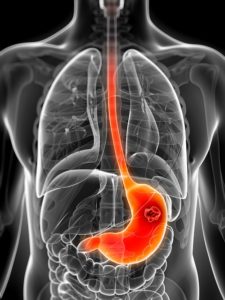Jump to:
What is Stomach Cancer?
–Types of Stomach Cancer?
Causes
Signs and Symptoms
–Risks of Developing Stomach Cancer?
Diagnosis
What is Stomach (Gastric) Cancer?
 Stomach cancer, also known as gastric cancer, is cancer that starts in any part of the stomach.
Stomach cancer, also known as gastric cancer, is cancer that starts in any part of the stomach.
Stomach cancer usually occurs first in the tissues that line the stomach. Precancerous changes in the stomach lining typically begin years before stomach cancer develops, though these changes rarely produce symptoms. In fact, stomach cancer often doesn’t exhibit symptoms until it is more advanced; only about 10 to 20 percent of stomach cancers in the USA are detected in their earliest stages.
The exact cause of stomach cancer is unknown but may be related to risk factors that include acid reflux, smoking and bacterial infection.
Stomach cancer develops most often in people over the age of 65 and is more common in men than in women and can also be affected by a number of other factors. It also is much more common in certain regions of Asia, Central and Eastern Europe, and Central and South America than in the United States, possibly due to lifestyle and environmental factors.
The American Cancer Society’s estimates for stomach cancer in the United States each year are:
- About 21,600 (13,230 in men and 8,370 in women)
- About 10,990 deaths (6,740 men and 4,250 women)
The average risk that a person will develop stomach cancer in their lifetime is about 1 in 116.
Until the late 1930s, stomach cancer was the leading cause of cancer death in the United States. No longer. The reasons for this decline are not completely known, but may be linked to increased use of refrigeration for food storage, fresh fruits and vegetables and decreased use of salted and smoked foods.
Some doctors think the decline may also be linked to the frequent use of antibiotics to treat infections. Antibiotics can kill the bacteria called Helicobacter pylori (H pylori), which is thought to be a major cause of stomach cancer.
Dr. Bilchik and his team, many of whom conduct translational cancer research are focused on providing more effective treatment that extends survival without impairing quality of life.
Types of Stomach Cancer
Up to 95% of stomach cancers are adenocarcinomas. These adenocarcinoma cancers are formed in the cells that line the stomach and can be divided into three types.
Stomach Cancer of the Fundus or Body
This type of cancer can develop from prolonged periods of inflammation and irritation. It is commonly associated with chronic infection with Helicobacter pylori (H. pylori) bacteria.
H. pylori is a spiral-shaped bacterium commonly found in the stomach. The bacteria’s shape and the way they move allow them to penetrate the stomach’s protective mucous lining, where they produce substances that weaken the lining and make the stomach more susceptible to damage from gastric acids.
The bacteria can also attach to cells of the stomach, causing stomach inflammation, and can stimulate the production of excess stomach acid. Over time, infection with the bacteria can also increase the risk of stomach cancer.
Although it is not known how H. pylori infection is spread, scientists believe it may be contracted through food and water. According to the National Institutes of Health, approximately 20% of people under the age of 40 and half of adults over 60 in the U.S. are infected, with higher rates in developing countries.
Having H. pylori infection doesn’t necessarily mean you’ll have ulcers or develop stomach cancer.
Diffuse Stomach Cancer
This type of cancer grows within the stomach wall as individual scattered cells rather than forming a lump or tumor. It can be very difficult to detect using standard endoscopic techniques and often multiple biopsies throughout the stomach are needed. Diffuse stomach cancer sometimes has a genetic cause.
Proximal or Gastroesophageal (GE) Junction Stomach Cancer
This type of stomach cancer affects the first part of the stomach and often extends into the area where the stomach and esophagus meet, known as the gastroesophageal junction. Risk factors for this type of cancer include obesity and gastroesophageal reflux disease. This is rapidly increasing in the USA.
Other less common types of stomach cancer include:
- Lymphoma: Cancer that begins in the cells of the immune system
- Gastrointestinal stromal tumor (GIST): Cancer of the muscle or connective tissue of the stomach wall
- Carcinoid tumors: Cancer of the hormone-producing cells of the stomach
Causes of Stomach Cancer
The cause of stomach cancer is largely unknown.
The following conditions are associated with a greater chance of getting stomach cancer
- Diabetes
- Smoking
- Obesity
- Alcohol abuse
- Family History
Signs and Symptoms of Stomach Cancer
The symptoms of stomach cancer are often similar to those of minor stomach issues including indigestion or a stomach virus. Because you may think you’re just experiencing a touch of the flu, you may not see your doctor as soon as you should. In fact, stomach cancer can often reach an advanced stage before symptoms even occur.
Symptoms of stomach cancer may include:
- Pain or discomfort in the stomach region
- Feeling bloated after eating
- Nausea and vomiting
- Unexplained weight loss
- Loss of appetite
- Heartburn
- Anemia
- Weakness and fatigue
- Difficulty swallowing or excessive belching with eating
- Vomiting blood or blood in the stool
If you experience these symptoms for more than 2-3 weeks you should definitely consult a doctor.
What Are the Risks of Stomach Cancer?
The following factors influence the risk of developing stomach adenocarcinoma:
- Infection with Helicobacter Pylori Bacteria
- Infection with the H. pylori bacteria may lead to chronic inflammation of the inner layer of the stomach and possibly the development of pre-cancers. Helicobacter pylori infection may also result in certain rare gastric lymphomas, which can be treated by treating the Helicobacter infection with antibiotics.
- Diet
- A diet high in smoked and salted foods, such as smoked fish, meat, and pickled vegetables, has been shown to increase a person’s chances of developing stomach cancer. High consumption of red meat also raises this risk. Conversely, eating a diet high in fruits and vegetables (particularly those high in beta-carotene and vitamin C) can decrease this risk. A deficiency in the dietary mineral known as selenium may also increase the risk of gastric cancer.
- Race
- Stomach cancer is more common among Asians, Pacific Islanders, Hispanics, and African Americans than Caucasians.
- Gender
- Stomach cancer is more common in men than in women.
- Age
- Stomach cancer is most commonly diagnosed in people over the age of 65.
Other possible risk factors include:
- Smoking and alcohol use
- Previous stomach surgery, such as removal of part of the stomach in individuals with ulcers
- Pernicious anemia, a very rare autoimmune condition in which the stomach no longer produces acid, making it hard to absorb vitamin B12
- Ménétrier disease, a very rare condition associated with the growth of large folds in the stomach and low production of stomach acids
- Blood type A (for unknown reasons)
- Family cancer syndromes, such as hereditary nonpolyposis colorectal cancer (HNPCC), also known as Lynch syndrome, Peutz-Jeghers syndrome, and familial adenomatous polyposis, all of which increase risk of colorectal cancer and slightly increase stomach cancer risk
- Family history of stomach cancer, possibly resulting from E-cadherin mutation
- Family history of breast cancer. People carrying mutations of the inherited genes BRCA1 and BRCA2 may also have a higher rate of stomach cancer.
- Stomach polyps (small benign growths that sometimes develop into stomach cancers)
- Obesity
Diagnosis
Diagnostic tests may include:
Fecal Occult Blood Test
This test checks for hidden blood in the stool. It involves placing a very small amount of stool on a special card, which is then tested in the doctor’s office or sent to a laboratory.
Upper GI (gastrointestinal) Series
Also called barium swallow, this test examines the organs of the upper part of the digestive system: the esophagus, stomach, and duodenum (the first section of the small intestine).
A fluid called barium – a metallic, chemical, chalky, liquid used to coat the inside of organs so that they will show up on an X-ray – is swallowed. X-rays are then taken to evaluate the digestive organs.
Esophagogastroduodenoscopy
Also called EGD or upper endoscopy, this procedure examines the inside of the esophagus, stomach, and duodenum. A thin, flexible, lighted tube, called an endoscope, is guided into the mouth and throat to visualize the esophagus, stomach, and duodenum. The endoscope also allows the insertion of instruments for removal of a sample of tissue for biopsy (if necessary).
Endoscopic Ultrasound
This imaging technique uses sound waves to create a computer image of the wall of the esophagus and stomach, as well as nearby lymph nodes. A small transducer that emits sound waves and receives their echoes is placed on the tip of an endoscope. The endoscope is guided into the mouth and throat, then into the esophagus and the stomach to visualize through the wall as well as surrounding lymph nodes.
Computed Tomography Scan (CT or CAT scan)
This noninvasive diagnostic imaging procedure uses a combination of X-rays and computer technology to produce horizontal, or axial, images (often called slices) of the body. A CT scan shows detailed images of any part of the body, including the bones, muscles, fat, and organs. CT scans are more detailed than general X-rays.


